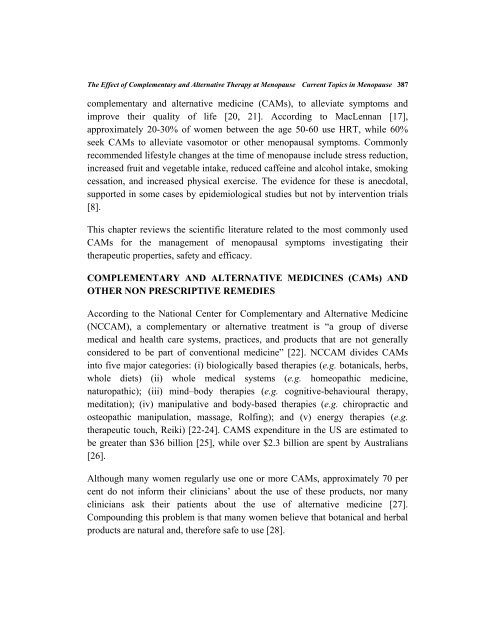Download - Bentham Science
Download - Bentham Science
Download - Bentham Science
You also want an ePaper? Increase the reach of your titles
YUMPU automatically turns print PDFs into web optimized ePapers that Google loves.
The Effect of Complementary and Alternative Therapy at Menopause Current Topics in Menopause 387<br />
complementary and alternative medicine (CAMs), to alleviate symptoms and<br />
improve their quality of life [20, 21]. According to MacLennan [17],<br />
approximately 20-30% of women between the age 50-60 use HRT, while 60%<br />
seek CAMs to alleviate vasomotor or other menopausal symptoms. Commonly<br />
recommended lifestyle changes at the time of menopause include stress reduction,<br />
increased fruit and vegetable intake, reduced caffeine and alcohol intake, smoking<br />
cessation, and increased physical exercise. The evidence for these is anecdotal,<br />
supported in some cases by epidemiological studies but not by intervention trials<br />
[8].<br />
This chapter reviews the scientific literature related to the most commonly used<br />
CAMs for the management of menopausal symptoms investigating their<br />
therapeutic properties, safety and efficacy.<br />
COMPLEMENTARY AND ALTERNATIVE MEDICINES (CAMs) AND<br />
OTHER NON PRESCRIPTIVE REMEDIES<br />
According to the National Center for Complementary and Alternative Medicine<br />
(NCCAM), a complementary or alternative treatment is “a group of diverse<br />
medical and health care systems, practices, and products that are not generally<br />
considered to be part of conventional medicine” [22]. NCCAM divides CAMs<br />
into five major categories: (i) biologically based therapies (e.g. botanicals, herbs,<br />
whole diets) (ii) whole medical systems (e.g. homeopathic medicine,<br />
naturopathic); (iii) mind–body therapies (e.g. cognitive-behavioural therapy,<br />
meditation); (iv) manipulative and body-based therapies (e.g. chiropractic and<br />
osteopathic manipulation, massage, Rolfing); and (v) energy therapies (e.g.<br />
therapeutic touch, Reiki) [22-24]. CAMS expenditure in the US are estimated to<br />
be greater than $36 billion [25], while over $2.3 billion are spent by Australians<br />
[26].<br />
Although many women regularly use one or more CAMs, approximately 70 per<br />
cent do not inform their clinicians’ about the use of these products, nor many<br />
clinicians ask their patients about the use of alternative medicine [27].<br />
Compounding this problem is that many women believe that botanical and herbal<br />
products are natural and, therefore safe to use [28].
















